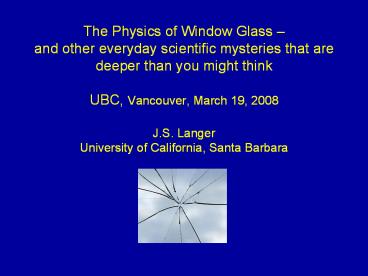The Physics of Window Glass PowerPoint PPT Presentation
Title: The Physics of Window Glass
1
The Physics of Window Glass and other everyday
scientific mysteries that are deeper than you
might thinkUBC, Vancouver, March 19, 2008J.S.
LangerUniversity of California, Santa Barbara
2
These are intellectually wonderful times for
science.
- Instruments allow us to see individual atoms and
the outer edges of the universe. - Computers solve complex mathematical problems and
simulate systems composed of millions of
molecules. - And now we can explore some old topics in new
ways - The mysterious glass transition.
- Snowflakes and pattern formation.
3
The Mysterious Glass Transition
Science Magazine, Vol. 309, 83
(2005) 125th Anniversary Issue 125 outstanding
problems in all of science
4
Ancient Egyptian glass jar from the New Kingdom
(Louvre)
5
Roman glass vessel, circa 50 AD 150 AD
6
Sainte Chapelle, Paris
7
(No Transcript)
8
A familiar, non-glassy, phase transition Water
freezes to become ice.
cool
Ice crystals form at a thermodynamic freezing
temperature. The energy of the crystal is lower
than that of the liquid. The crystal is in a
state of thermodynamic equilibrium.
9
Copper-Nickle alloy micrograph showing
dendritic
(snowflake-like) crystals
10
The glass transition from liquid-like to
solid-like states is very different from crystal
growth.
Glass Blowing
11
The Glass TransitionDramatic change in
viscosity, no crystallization
Place a drop of hot molten glass on a table.
- It spreads instantly.
12
- A slightly cooler drop takes minutes to spread.
13
- A yet cooler drop takes years or centuries.
- And an even cooler drop may keep its shape for
times longer than the age of the universe. It
seems to be infinitely viscous.
A glass is not in a state of thermodynamic
equilibrium.
14
Why is it important to understand this phenomenon?
- Most everyday materials, including biological
materials, are noncrystalline. Or else, like
sand, they are highly disordered arrangements of
tiny crystals. - Most everyday materials are not in mechanical
and/or thermal equilibrium. We need to
understand how they function, deform and break.
15
T. Haxton and A. Liu MD simulation of 2D glass.
The temperature is nonzero but is below the glass
transition the shear rate is constant but very
small on the molecular time scale.
16
Initial state
17
New state
18
Elements of a Theory
- As temperature decreases, thermal noise becomes
weaker. - Molecular rearrangements require thermally
excited motions of increasingly large numbers of
molecules perhaps chains of small
displacements. - The probability that these motions will happen
becomes very small (? zero ?) as the temperature
decreases.
This is a theoretical work in progress.
19
At low temperatures, glasses become brittle.
20
Brittle fracture patterns look like snowflakes,
or butterfly wings, or ...??
21
Snowflakes and Pattern Formation
K. Libbrecht Snowflake
22
(No Transcript)
23
Johannes Kepler (1571-1630, most famous for his
laws of planetary motion) may have been the first
person who thought that natural pattern formation
could be understood scientifically.
24
(No Transcript)
25
(No Transcript)
26
(No Transcript)
27
Succinonitrile dendrite much less complicated
than water for scientific purposes.
28
Succinonitrile
29
Scanning electron micrograph of a Nickel-based
alloy
30
Instability The key to pattern formation
liquid
Diffusion of heat or molecules is fastest at
surface irregularities (the lightning-rod
effect). Therefore irregularities sharpen and
grow.
crystalline solid
What triggers this instability? Why do
irregularities occur?
31
Albert Einstein, ca. 1905
32
Molecular Chaos
Molecular chaos was understood first by Einstein
in 1905 (the same year in which he wrote his
papers on special relativity and the photelectric
effect). He studied the irregular Brownian
motion of very small dust particles in water.
He used statistical methods to deduce from this
motion the number of molecules in a cubic
centimeter of water. His answer was approximately
1023 100,000,000,000,000,000,000,000.
33
Molecular Chaos and Snowflakes
We now understand that complex dendritic patterns
are triggered by molecular chaos. The growing
dendrite selectively amplifies by a huge amount
the microscopic molecular fluctuations at its
tip.
34
(No Transcript)
35
SN dendrites at six different temperatures. The
position of the first sidebranches can be
predicted accurately by the thermal fluctuation
theory.
36
The new frontiers in the science of pattern
formation (morphogenesis) are in biology.
What tricks does Nature use to form biological
patterns? In what ways are these patterns similar
to fracture and snowflakes? Or are they entirely
different?
37
(No Transcript)
38
(No Transcript)
39
(No Transcript)
40
Conch shell
41
(No Transcript)
42
Two concluding remarks
- The glass transition, and pattern formation in
physics and biology, are examples of complex,
dynamic, nonequilibrium phenomena that we are
only just beginning to understand. - The big challenge will be to develop a broadly
applicable science of complexity that is both
quantitative and predictive.

